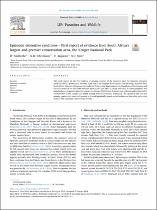Epizootic ulcerative syndrome – first report of evidence from South Africa's largest and premier conservation area, the Kruger National Park
| dc.contributor.author | Christison, Kevin | |
| dc.date.accessioned | 2022-12-05T10:59:26Z | |
| dc.date.available | 2022-12-05T10:59:26Z | |
| dc.date.issued | 2019 | |
| dc.identifier.citation | Malherbe, W., Christison, K. W., Wepener, V., & Smit, N. J. (2019). Epizootic ulcerative syndrome - First report of evidence from South Africa's largest and premier conservation area, the Kruger National Park. International journal for parasitology. Parasites and wildlife, 10, 207–210. https://doi.org/10.1016/j.ijppaw.2019.08.007 | en_US |
| dc.identifier.issn | 2213-2244 | |
| dc.identifier.uri | http://hdl.handle.net/10566/8244 | |
| dc.description.abstract | This study reports on the first evidence of genomic material of the causative agent for epizootic ulcerative syndrome (EUS), Aphanomyces invadans, from fish in the Limpopo River system and the Kruger National Park, South Africa. Fourteen fish species were collected from various depressions in the floodplains of the Limpopo and Luvuvhu Rivers in the Makuleke Wetlands during 2015 and 2017. | en_US |
| dc.language.iso | en_US | en_US |
| dc.publisher | ScienceDirect | en_US |
| dc.subject | Aphanomyces invadans | en_US |
| dc.subject | Makuleke | en_US |
| dc.subject | Ramsar | en_US |
| dc.subject | Clarias gariepinus | en_US |
| dc.subject | Oomycete | en_US |
| dc.title | Epizootic ulcerative syndrome – first report of evidence from South Africa's largest and premier conservation area, the Kruger National Park | en_US |
| dc.type | Article | en_US |

